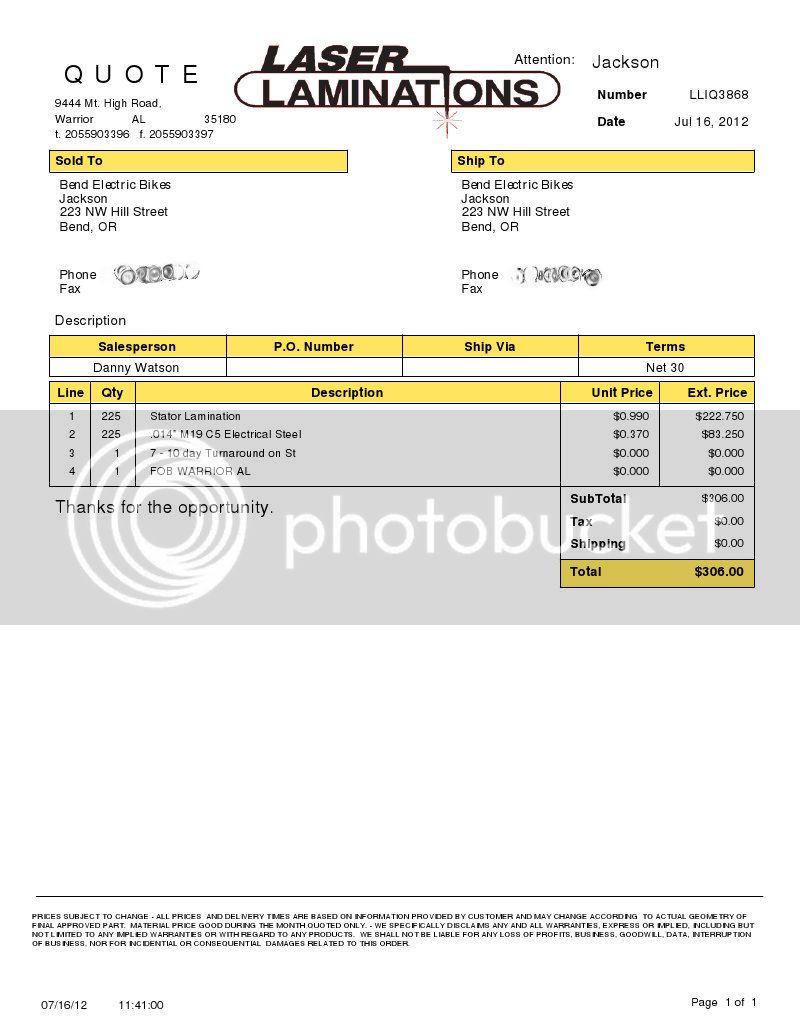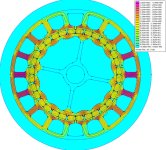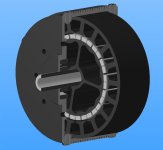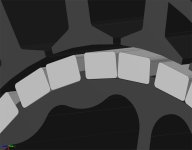You are using an out of date browser. It may not display this or other websites correctly.
You should upgrade or use an alternative browser.
You should upgrade or use an alternative browser.
Miles' 90mm inrunner build thread
- Thread starter Miles
- Start date
Jeremy Harris
100 MW
I'll be watching this with serious interest, Miles!
Looking forward to your comments, Jeremy!Jeremy Harris said:I'll be watching this with serious interest, Miles!
The idea is to have something that runs at 3000rpm and can generate up to 5Nm of torque, continuously... We'll see...
I was originally going to do this with 20 poles but I've dropped to 16 to keep the fundamental frequency below 400hz, which seems to be the maximum recommended for 0.35mm laminations. This will help keep the costs down.
Magnets are N30 SH, again for economic reasons.
I was originally going to do this with 20 poles but I've dropped to 16 to keep the fundamental frequency below 400hz, which seems to be the maximum recommended for 0.35mm laminations. This will help keep the costs down.
Magnets are N30 SH, again for economic reasons.
I did experiment with that idea. It's terribly wasteful of magnet, though, a lot of flux is inevitably short circuited.circuit said:I'm wondering how you are going to keep the magnets from flying away. Would not it be better to simply embed the magnets under the surface of rotor's lamination? Should not be hard to do in this configurarion.
Ref: http://www.endless-sphere.com/forums/viewtopic.php?f=30&t=41153
Anyway, 3000rpm isn't so fast. I was planning to wrap a single strand Kevlar thread around the magnets and impregnate it with epoxy.
John in CR
100 TW
Great to see you going for one Miles. How much do you think the laminations and whatever insulates them from each other will cost? If it helps you get a better price, I'd be interested in buying some too.
I haven't got any quotes for laminations yet. I'd guess a one off .35mm C5 lamination stator/rotor set would be somewhere between $150 and $200? To get things cheaper, you'd need to have them stamped in large quantity.
Let's try this out as a prototype, first. If it's any good, I'll think about putting a kit together for people to make their own.
Let's try this out as a prototype, first. If it's any good, I'll think about putting a kit together for people to make their own.
John in CR
100 TW
Miles said:I haven't got any quotes for laminations yet. I'd guess a one off .35mm C5 lamination stator/rotor set would be somewhere between $150 and $200? To get things cheaper, you'd need to have them stamped in large quantity.
Let's try this out as a prototype, first. If it's any good, I'll think about putting a kit together for people to make their own.
Great, that sounds even better. I especially like that you chose a tooth count divisible by 6.
liveforphysics
100 TW
Taught kevlar thread wrapped magnets impregnated with epoxy seem to stay on pretty well. Don't underestimate getting it taught while wrapping though, putting the rotor in a lathe set for a very slow speed seems to help. Wet the magnets first as well, so the thread lays in epoxy, then gets it brushed on the back side as well. Kevlar doesn't seem to just soak in the epoxy when you wet it from the outside nearly as well as fiberglass.
I agree though, low RPM's and a small magnet radius should make it pretty easy to keep these magnets attached.
Looks like generous room for copper with those narrow teeth. Definitely going for efficiency over burst torque, and I think that's a good move for your application.
I agree though, low RPM's and a small magnet radius should make it pretty easy to keep these magnets attached.
Looks like generous room for copper with those narrow teeth. Definitely going for efficiency over burst torque, and I think that's a good move for your application.
Thanks for your thoughts, Luke.
Ryan gave me some other ideas but I thought I'd try the Kevlar thread technique first. I have some experience of winding strings on musical instruments, so I'm not too daunted by this I've allowed an 0.8mm gap which will include the Kevlar wrap and hopefully allow sufficient clearance/tolerance room....
I've allowed an 0.8mm gap which will include the Kevlar wrap and hopefully allow sufficient clearance/tolerance room....
It will be interesting to compare the performance of this with the Astro motors. Although both are inrunners of a similar size and weight, they are very different in almost every other aspect.
Ryan gave me some other ideas but I thought I'd try the Kevlar thread technique first. I have some experience of winding strings on musical instruments, so I'm not too daunted by this
It will be interesting to compare the performance of this with the Astro motors. Although both are inrunners of a similar size and weight, they are very different in almost every other aspect.
Jeremy Harris
100 MW
The forces on the magnet bond are small, not worth worrying about in my view. By all means add a Kevlar binding, but it almost certainly isn't needed at this sort of rpm and rotor radius.
If you're using magnets that weigh, say, 10g (probably pessimistic), have a rotor diameter of 90mm and spin it at 3000 rpm then the centripetal force acting on the magnet/rotor bond is only around 44N, or about 10 lbsf. The motor torque reaction will be primarily in shear, I would think, and probably adds little to the overall bond stress. The bond strength of a good epoxy on a well-prepared metal to metal joint will be around 6 to 8 N/mm² in shear and maybe 2 to 3 N/mm² tensile. My guess is that your magnets will have a bond area of somewhere between 200 and 300 mm², so just a good epoxy alone will be OK for around 8 times the load that the magnets will see.
If you're using magnets that weigh, say, 10g (probably pessimistic), have a rotor diameter of 90mm and spin it at 3000 rpm then the centripetal force acting on the magnet/rotor bond is only around 44N, or about 10 lbsf. The motor torque reaction will be primarily in shear, I would think, and probably adds little to the overall bond stress. The bond strength of a good epoxy on a well-prepared metal to metal joint will be around 6 to 8 N/mm² in shear and maybe 2 to 3 N/mm² tensile. My guess is that your magnets will have a bond area of somewhere between 200 and 300 mm², so just a good epoxy alone will be OK for around 8 times the load that the magnets will see.
Jeremy Harris
100 MW
That configuration is great for bonding, as adhesives are generally far better in shear than they are in tension. I suspect the bond areas on the small locating upstands will be more than enough to hold the magnets against the modest centripetal force, and the adhesive overall stress levels will be lowered by not having to take any of the shear reaction from torque.
BTW, assuming a density of 7.5gm cm³, the magnets weigh as much as 3.35 grams each 
Magnet dimensions are 30mm x 5mm x 3mm.
Rotor diameter is only 60mm (sorry, I should have made that clearer...) 90mm is the outside diameter of the case.
Magnet dimensions are 30mm x 5mm x 3mm.
Rotor diameter is only 60mm (sorry, I should have made that clearer...) 90mm is the outside diameter of the case.
Jeremy Harris
100 MW
In that case my assumptions were well and truly pessimistic!
I reckon the magnets would almost stay in place just from attraction to the back iron. A decent epoxy adhesive (my favourite would be Hysol - I've used it to bond alloy aircraft wings together) would be more than strong enough to hold the magnets in place at around two or three times the design rpm (bearing in mind that the tensile force increases in proportion to the square of rpm).
I reckon the magnets would almost stay in place just from attraction to the back iron. A decent epoxy adhesive (my favourite would be Hysol - I've used it to bond alloy aircraft wings together) would be more than strong enough to hold the magnets in place at around two or three times the design rpm (bearing in mind that the tensile force increases in proportion to the square of rpm).
The continuous torque rating of the Astro 32XX series is 1Nm per cm of stator length.
The rotor of my motor has 1.43x the surface area of the Astro, per unit length.
The airgap radius is also 1.43x greater, of course.
I'm hoping this will give me around twice the torque rating per unit length......
30mm x 2Nm = 6Nm. My target is 5Nm - I don't want to run as hot as the Astros......
The rotor of my motor has 1.43x the surface area of the Astro, per unit length.
The airgap radius is also 1.43x greater, of course.
I'm hoping this will give me around twice the torque rating per unit length......
30mm x 2Nm = 6Nm. My target is 5Nm - I don't want to run as hot as the Astros......
liveforphysics
100 TW
Jeremy Harris said:That configuration is great for bonding, as adhesives are generally far better in shear than they are in tension. I suspect the bond areas on the small locating upstands will be more than enough to hold the magnets against the modest centripetal force, and the adhesive overall stress levels will be lowered by not having to take any of the shear reaction from torque.
If the magnets are chrome/nickel plated, I find most any glue tends to bond better to the coating than the coating bonds to the magnet material. Just something ti remember when working on bonding designs.
liveforphysics
100 TW
A Joby motors magnets do have each magnet masked, and sand blasted off to remove the coating do the epoxy can bond.
You can alternatively order magnets with a black epoxy coating.
And O2 exposed uncoated magnet surface begins to oxidize very rapidly. On the order of hours to a day or so.
You can alternatively order magnets with a black epoxy coating.
And O2 exposed uncoated magnet surface begins to oxidize very rapidly. On the order of hours to a day or so.
Farfle
100 kW
Not sure if you have a source or not, but laser laminations out of Warrior AL, was very easy to work with, and were very interested in a small motor project. Plus the price quote from them was only $300 for my big outrunner's lams (.014" ~ 0.35mm)


Similar threads
- Replies
- 7
- Views
- 508
- Replies
- 36
- Views
- 2,127




